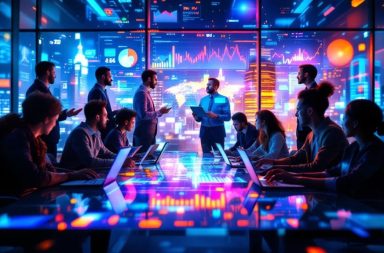The Evolution of Artificial Intelligence: From Concept to Reality
The Evolution of Artificial Intelligence: From Concept to Reality
Artificial Intelligence (AI) has transitioned from a futuristic concept to a tangible reality that influences various aspects of our daily lives. From virtual assistants like Siri and Alexa to advanced machine learning algorithms that power recommendation systems, AI is reshapingFloating Solar Farms: Floating solar farms are gaining popularity, particularly in regions with limited land availability. These installations utilize bodies of water, such as reservoirs and lakes, to deploy solar panels, reducing land use and minimizing evaporation while generating clean energy.
industries and enhancing human capabilities. This blog post delves into the evolution of AI, exploring its historical milestones, current applications, and future potential.
The Birth of Artificial Intelligence
The roots of artificial intelligence can be traced back to ancient history, where myths and stories featured artificial beings endowed with intelligence. However, the formal study of AI began in the mid-20th century. In 1956, the Dartmouth Conference, organized by John McCarthy, Marvin Minsky, Nathaniel Rochester, and Claude Shannon, marked the birth of AI as a field of study. The conference aimed to explore the potential of machines to simulate human intelligence.
During this period, researchers developed early AI programs, such as the Logic Theorist, created by Allen Newell and Herbert A. Simon. This program was capable of solving mathematical theorems, demonstrating that machines could perform tasks that required human-like reasoning.
The Rise and Fall of AI: The First and Second AI Winters
The initial excitement surrounding AI led to significant investments and advancements. However, by the 1970s, progress slowed, leading to what is known as the “First AI Winter.” Researchers faced challenges in developing practical applications, and funding decreased as expectations exceeded reality.
Despite this setback, AI research continued, and the 1980s saw a resurgence in interest, often referred to as the “Second AI Winter.” This period was characterized by the development of expert systems—programs designed to mimic human expertise in specific domains. Companies invested heavily in these systems, leading to practical applications in industries such as finance and healthcare.
The Advent of Machine Learning
The resurgence of AI in the 21st century can be attributed to the advent of machine learning, a subset of AI that focuses on algorithms that enable computers to learn from data. In 2006, Geoffrey Hinton and his colleagues introduced the concept of “deep learning,” a technique that uses neural networks to process vast amounts of data. This breakthrough allowed machines to achieve unprecedented levels of accuracy in tasks such as image and speech recognition.
The availability of large datasets, coupled with advancements in computing power, fueled the rapid development of machine learning algorithms. Companies like Google, Facebook, and Amazon began leveraging these technologies to enhance their products and services, leading to a proliferation of AI applications.
Current Applications of Artificial Intelligence
Today, AI is embedded in various aspects of our lives, with applications spanning multiple industries:
Floating Solar Farms: Floating solar farms are gaining popularity, particularly in regions with limited land availability. These installations utilize bodies of water, such as reservoirs and lakes, to deploy solar panels, reducing land use and minimizing evaporation while generating clean energy.
Healthcare: AI is revolutionizing healthcare by improving diagnostics, personalizing treatment plans, and streamlining administrative tasks. Machine learning algorithms analyze medical images to detect diseases such as cancer at early stages, while natural language processing (NLP) systems assist healthcare professionals in managing patient records.
Finance: In the financial sector, AI algorithms analyze market trends, assess risks, and automate trading decisions. Robo-advisors provide personalized investment advice based on individual risk profiles, while fraud detection systems use machine learning to identify suspicious transactions in real time.
Transportation: The rise of autonomous vehicles is one of the most significant advancements in transportation. Companies like Tesla and Waymo are utilizing AI to develop self-driving cars that can navigate complex environments. AI also optimizes logistics and supply chain management, improving efficiency and reducing costs.
Retail: AI enhances the retail experience through personalized recommendations and inventory management. E-commerce platforms use machine learning algorithms to analyze customer behavior and preferences, delivering tailored product suggestions that drive sales.
Customer Service: AI-powered chatbots and virtual assistants are transforming customer service by providing instant support and resolving queries without human intervention. These systems use NLP to understand and respond to customer inquiries, improving response times and customer satisfaction.
The Ethical Considerations of AI
As AI continues to evolve, ethical considerations surrounding its use have become increasingly important. Key concerns include:
Bias and Fairness: AI algorithms can inadvertently perpetuate biases present in training data, leading to unfair outcomes. For example, facial recognition systems have been shown to have higher error rates for individuals from marginalized communities. Ensuring fairness and transparency in AI systems is critical to building trust.
Privacy: The use of AI often involves processing vast amounts of personal data, raising concerns about privacy and data security. Organizations must implement robust data protection measures and comply with regulations to safeguard user information.
Job Displacement: The automation of tasks traditionally performed by humans raises concerns about job displacement. While AI can enhance productivity, it is essential to consider the implications for the workforce and invest in reskilling and upskilling initiatives.
The Future of Artificial Intelligence
Looking ahead, the future of AI holds exciting possibilities:
General Artificial Intelligence (AGI): While current AI systems excel at specific tasks, the pursuit of AGI—machines that possess human-like intelligence—remains a long-term goal. Achieving AGI would revolutionize industries and society, but ethical considerations must be addressed to ensure responsible development.
AI in Creative Fields: AI is beginning to make inroads into creative fields, generating art, music, and literature. As these technologies advance, we may witness new forms of collaboration between humans and machines in creative endeavors.
AI for Social Good: AI has the potential to address global challenges, such as climate change, poverty, and healthcare access. Initiatives leveraging AI for social good are gaining traction, with organizations using AI to analyze data and develop solutions for pressing societal issues.
Human-AI Collaboration: The future of work will likely involve collaboration between humans and AI systems. Rather than replacing human jobs, AI will augment human capabilities, enabling workers to focus on higher-level tasks that require creativity, critical thinking, and emotional intelligence.
Conclusion
The evolution of artificial intelligence has been a remarkable journey from theoretical concepts to practical applications that impact our daily lives. As AI continues to advance, it is essential to navigate the ethical considerations and challenges that arise. By fostering responsible development and collaboration between humans and machines, we can harness the full potential of AI to create a better future for all.
AI is not just a technological advancement; it is a transformative force that has the power to reshape industries, enhance human capabilities, and address some of the world’s most pressing challenges. As we embrace this evolution, staying informed and engaged in the conversation surrounding AI will be crucial in ensuring its responsible and beneficial integration into society.



